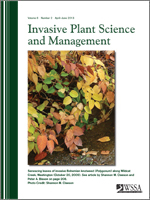Macartney rose is an aggressive thorny shrub that displaces forage species and hinders cattle grazing in rangelands and pastures of the southern United States. Historically, Macartney rose has proven to be extremely difficult to control even with high rates of soil residual herbicides such as picloram. Recent advances in herbicide chemistry warrant testing on this troublesome species. We compared mowing and late summer broadcast applications of thirteen herbicide treatments that included combinations of aminopyralid, fluroxypyr, metsulfuron, picloram, triclopyr, and 2,4-D. Treatments were applied to the same rose clumps for 2 consecutive yr. An additional mowing was done to one half of the rose clumps in each treatment 6 mo after the second herbicide treatment. At 11 mo after initial treatment (MAIT), mowing and all herbicide treatments performed very poorly and provided 35% control or less. At 12 mo after retreatment (24 MAIT), picloram 2,4-D and aminopyralid metsulfuron, both followed by mowing, were the most effective treatments, providing 72 to 91% control. All other treatments provided less than 70% control. However, complete clump mortality was very low across all treatments, ranging from 3 to 32%. These results indicate that Macartney rose suppression is possible with certain new herbicides, but complete clump kill is still lacking.
Nomenclature: Aminopyralid, fluroxypyr, metsulfuron, picloram, triclopyr, 2,4-D, Macartney rose, Rosa bracteata J. C. Wendl. ROSBC
Management Implications: Macartney rose is one of the most difficult-to-control thorny shrubs in pastures across the Southeast. We evaluated a suite of newer pasture herbicides that included several combinations of 2,4-D, aminopyralid, fluroxypyr, metsulfuron, picloram, and triclopyr. Broadcast treatments were applied for 2 consecutive yr in August over the same individual rose clumps and mowing was done 6 mo after the second application. We found that none of the herbicides and rates tested effectively killed entire clumps but that Macartney rose was suppressed best with picloram 2,4-D treatments. Triclopyr was ineffective when applied alone or when tank-mixed with aminopyralid 2,4-D or aminopyralid metsulfuron. Metsulfuron was also ineffective and did not improve control when applied with aminopyralid alone or in combination with 2,4-D. These results indicate that typical annual broadcast applications currently utilized for broadleaf pasture weed control will not effectively eliminate the invasive shrub Macartney rose and more integrated methods need to be evaluated.





